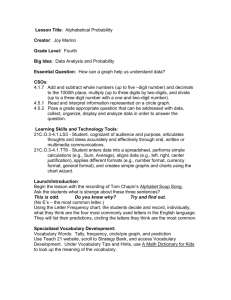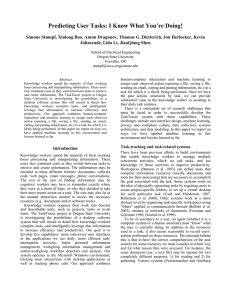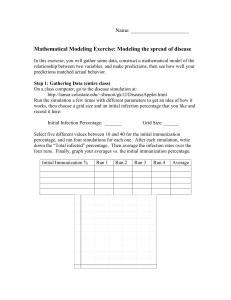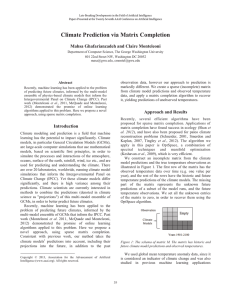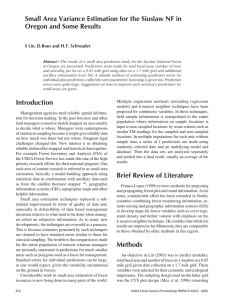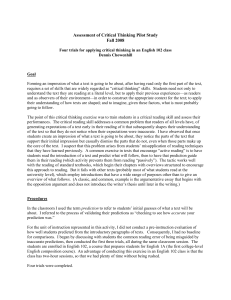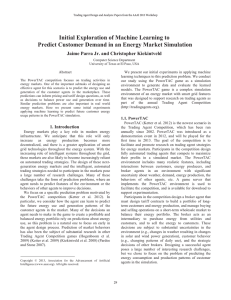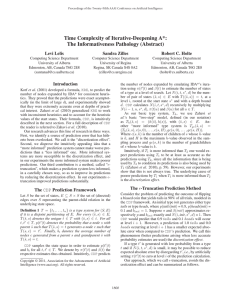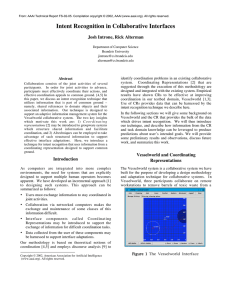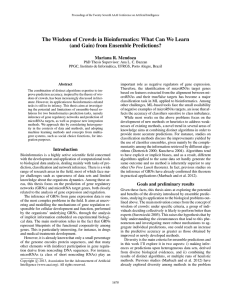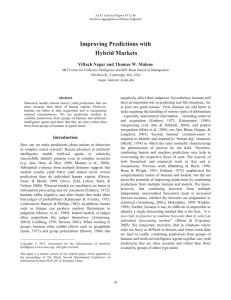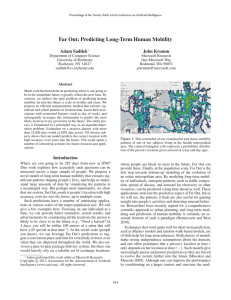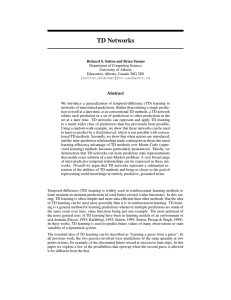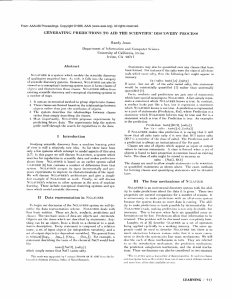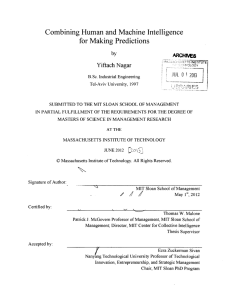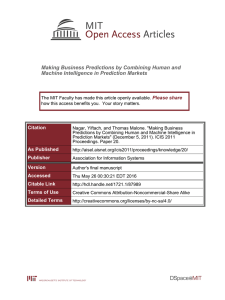Lesson Title Creator Grade Level: Big Idea
advertisement
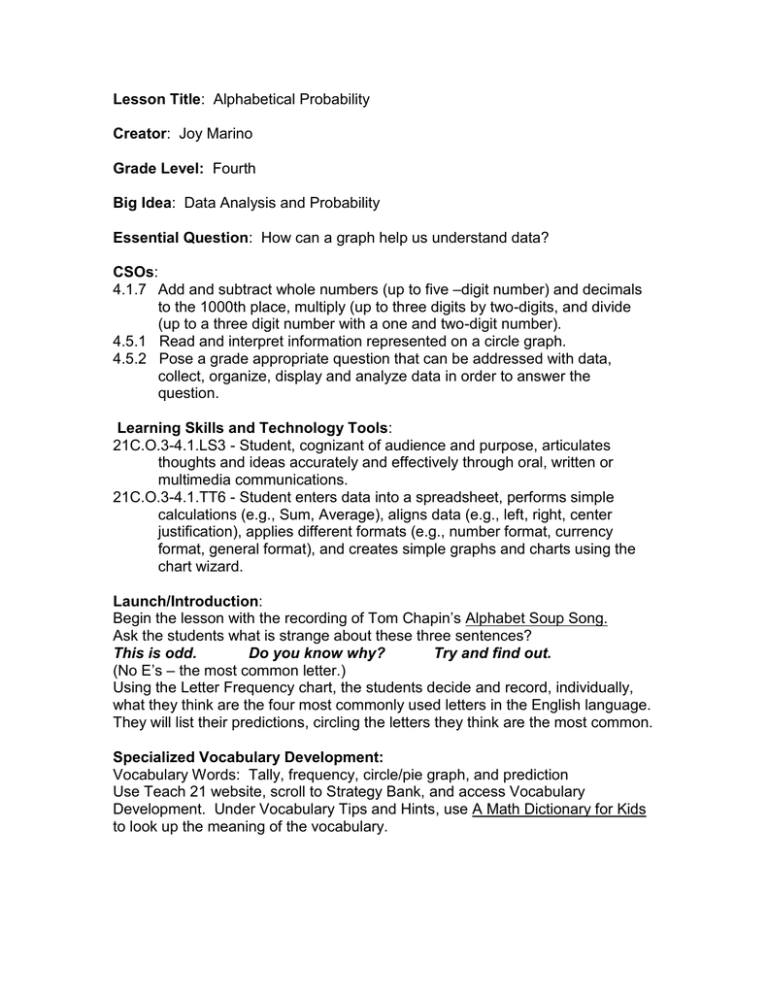
Lesson Title: Alphabetical Probability Creator: Joy Marino Grade Level: Fourth Big Idea: Data Analysis and Probability Essential Question: How can a graph help us understand data? CSOs: 4.1.7 Add and subtract whole numbers (up to five –digit number) and decimals to the 1000th place, multiply (up to three digits by two-digits, and divide (up to a three digit number with a one and two-digit number). 4.5.1 Read and interpret information represented on a circle graph. 4.5.2 Pose a grade appropriate question that can be addressed with data, collect, organize, display and analyze data in order to answer the question. Learning Skills and Technology Tools: 21C.O.3-4.1.LS3 - Student, cognizant of audience and purpose, articulates thoughts and ideas accurately and effectively through oral, written or multimedia communications. 21C.O.3-4.1.TT6 - Student enters data into a spreadsheet, performs simple calculations (e.g., Sum, Average), aligns data (e.g., left, right, center justification), applies different formats (e.g., number format, currency format, general format), and creates simple graphs and charts using the chart wizard. Launch/Introduction: Begin the lesson with the recording of Tom Chapin’s Alphabet Soup Song. Ask the students what is strange about these three sentences? This is odd. Do you know why? Try and find out. (No E’s – the most common letter.) Using the Letter Frequency chart, the students decide and record, individually, what they think are the four most commonly used letters in the English language. They will list their predictions, circling the letters they think are the most common. Specialized Vocabulary Development: Vocabulary Words: Tally, frequency, circle/pie graph, and prediction Use Teach 21 website, scroll to Strategy Bank, and access Vocabulary Development. Under Vocabulary Tips and Hints, use A Math Dictionary for Kids to look up the meaning of the vocabulary. Investigate/Explore: Divide the students into groups and ask the students to share their individual predictions and arrive at one group prediction. Record group predictions of the four most commonly used letters on the Letter Frequency Chart under Group Prediction. Using their social studies or science books and the Letter Frequency Chart, have each student pick a random sentence from their book and tally how many times each letter appears in the sentence. Then have groups compile their individual results, record, and discuss the group results on the Letter Frequency Chart under Group Results. Question: How did your group’s prediction compare with the group results? To record class results, use the Class Results Data Collection Chart. One student will report the group results from each group. All students will record in the correct letter box and add to find the class results which will be recorded on their Letter Frequency Charts. After recording is completed, have the groups compare and discuss their individual and group predictions with group and class results. Question: Are the class results the same as your groups’ prediction? Analyze the Letter Frequency Chart and list the Class Results of the Four Most Frequent Letters according to the students’ findings. Refer back to the three sentences in the Launch section. Repeat the question: What is strange about these three sentences? Summarize/Debrief the Lesson: After the teacher models, the students will construct a circle graph of Class Results findings using Excel Chart Wizard. Students will enter the actual count for each letter. Percents can also be selected in Excel. Compare the class results with students’ individual predictions and the actual order of frequency in the English language: E T A O [NI] S R H L D C U [PF] M W Y [BG] V K [QX] [JZ] (Those bracketed have the same frequency of occurrence.) Exit Slip Question: How can a graph help us understand data? End the Lesson with Tom Chapin’s Alphabet Soup Song. EXTENSIONS: Using Rosetta Stone, find out if this would be the same for other languages. Have students write, or talk, without using one of the common letters. Text messaging! Each letter in the cryptogram below stands for another letter in the alphabet. Can you figure out what it says? AB CD EDDF AG FXD HIJY, A CAKK LMN NZM IG AWD WJDIE WZGD. Here’s a clue to help you: The most frequently used words in the English language are: the, and, a, an. Answer: If we meet in the park, I will buy you an ice cream cone. Examine the games of Scrabble, Boggle, and so forth to see how they used the information about frequency of letters. Buy some transfer lettering from a stationary or art store. Analyze the frequency of the letters provided. MATERIALS: Paper, pencil, data projector, Smartboard, calculators, Science or Social Studies textbook, Letter Frequency Chart, Class Results Data Collection Chart, computer/s, Rosetta Stone software, Scrabble and Boggle games, and transfer lettering. DURATION: Ninety minutes
